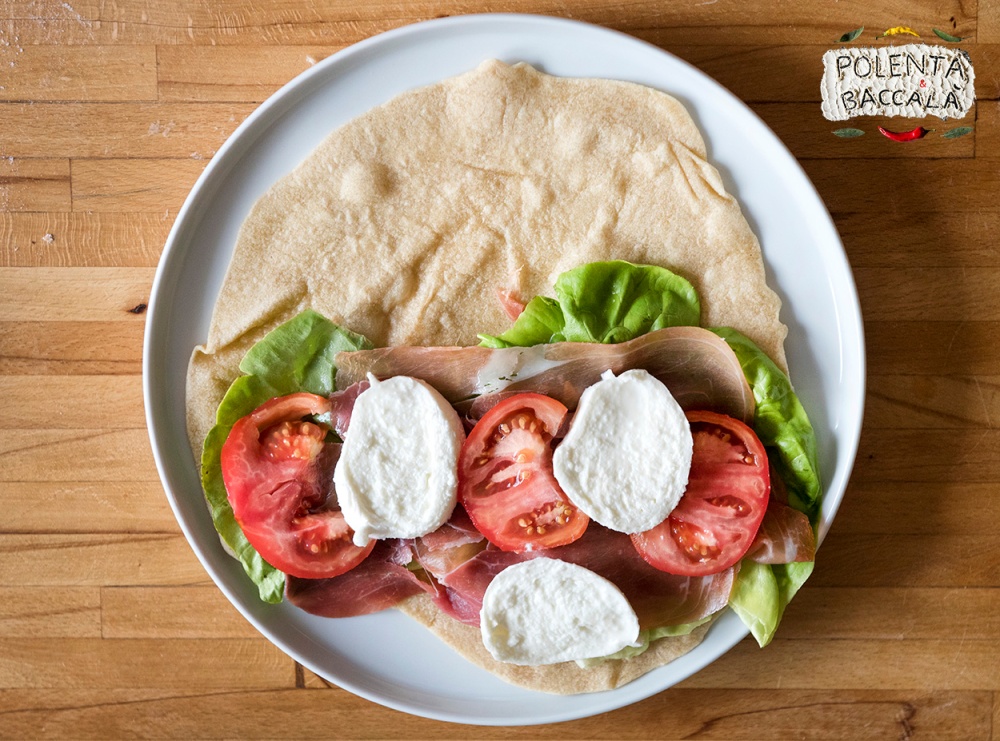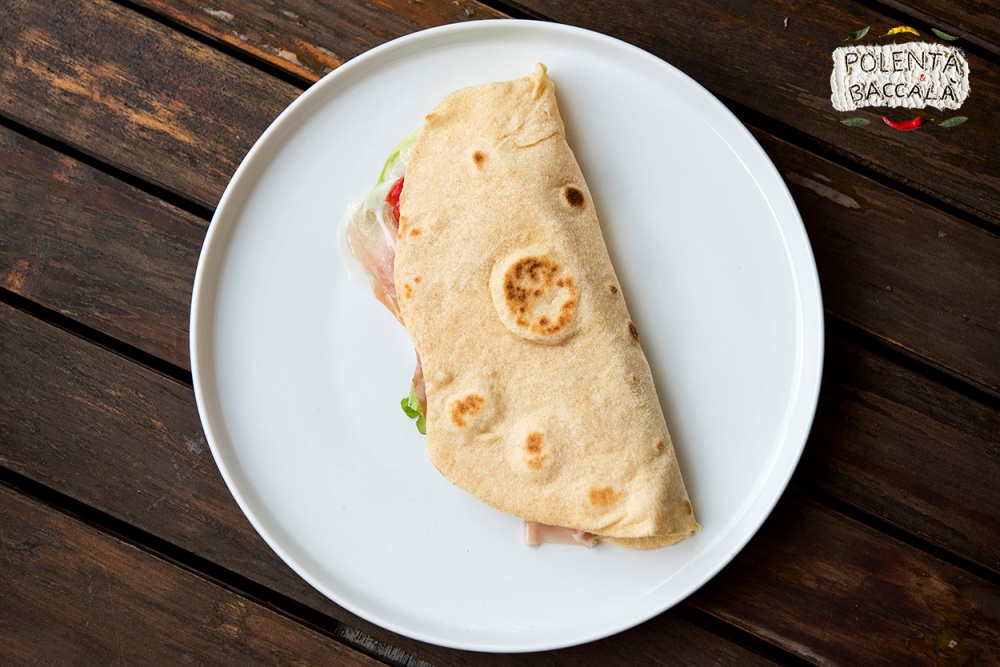
In Italy, especially some areas of northern Italy, summer means also Piadina Romagnola 🙂
It’s probably the most famous Italian flatbread (after pizza, but that’s a category itself), and a very good and comfortable street food.
It’s typical of Emilia-Romagna region (but only the Romagna part), and through all its territory its style gradually changes: in the more interior areas it’s usually thicker (also 7-8 mm), then moving in the direction of the sea it’s gradually being made thinner, reaching its thinnest versions in the surroundings of Rimini and Riccione, the famous local touristic spots by the sea, where the piadina is made no more than 2-3 mm thick.
It’s not too difficult, and the traditional ingredients are simple: flour, water, salt and lard. If you really have problems with the lard then the only accepted alternative is extra virgin olive oil. But in my opinion the lard is better in this case, and almost all the people in its area of origin agree with that 🙂
If you do it at home it’s always better than most of the industrial piadina, for sure you’ll not eat diphosphates and other additives often used in many industrial piadinas.
The use of yeast/sodium bicarbonate is relatively recent, since about the ’30s when exactly the sodium bicarbonate began to be used (but giving a yellowish color to the piadina). Then lately also yeast arrived in the modern recipes. But in the very past none of them were used, and still nowadays many people don’t use them. In all the cases you’ll be able to obtain a good piadina 🙂 Some people use milk rather than water: the piadina will be softer, but it’s not a traditional ingredient and the “purists” use only water.
Traditionally it’s filled with local cured ham (Parma is very close) and a typical local cheese, the Squacquerone. But the options are countless. And again traditionally the piadina is cooked in the Testo, a special pan made of terracotta or cast iron, which is giving to the piadina the perfect taste 🙂 but also in a normal pan will be good 🙂
Flour: we need a weak flour, with a lower protein content (around 10-11%), so not those flours which are perfect for sourdough bread, pizza, panettone, etc. in Italy the suggested flour is usually the “Tipo 0” (All-purpose). A strong flour, with higher gluten content, will make the piadina more chewy.
INGREDIENTS (for 4 piadine):
- 300 g flour
- 150 g warm water
- 50 g lard
- 6 g salt
- a pinch of sodium bicarbonate (optional)
- Sift the flour, add the lard in the middle, the salt, the sodium bicarbonate (if you want) and add gradually the warm water. Mix until you have a dough easy to handle. Then start working the dough, for about 10 minutes.
- Then cover and let it rest for about 45-60 minutes (if you don’t use sodium bicarbonate/yeast wait about 2 hours).

- Divide the dough into 4-5 smaller balls, spread some flour on your working table and flatten the dough using a rolling pin. Give a circular shape and flatten until the desired thickness.
- Now heat a pan, and when it’s hot you can cook your piadina, depending on the thickness between 60 and 90 seconds on each side. It will make bubbles while cooking, you can make some holes with a fork so it will cook better.

- Garnish your piadina how you prefer: I used Parma ham, buffalo mozzarella DOP, salad and tomatoes. Simple and perfect 🙂 you can simply bend it in half, or you can also roll it and then cut in half, like a wrap.
PS: in the photos it’s a bit darker than usual because in this case I tried using 1/3 of a less refined flour.


Never heard of this lovely flat bread. It looks so good. I will try to make it soon!
LikeLiked by 1 person
Thank you 🙂 in Italy it’s very famous 🙂
LikeLiked by 1 person
I’m on team Ronit and have never heard of this flat bread. But then again I’ve also never traveled to that region of Italy. Hum, maybe I’ll have to make a visit…. I’m looking forward to trying out this recipe and I’m going to be a purist and use lard. Thanks for sharing this Migraine-friendly recipe with us. Bravo 💜💜💜💜
LikeLiked by 1 person
Thank you 🙂 especially in summer you could find it also in some other regions, mostly in northern-central Italy (but the best and usually always freshly made you’ll find in the mentioned region).
In the neighbor Marche region there is an apparently similar but different piadina, called “crescia” or “piadina sfogliata marchigiana”, maybe I’ll do a post also about that 🙂
LikeLiked by 1 person
Okay, you’ve convinced me to forget about the store-bought piadine and to make my own. Thank you for the inspiration! (sometimes I just need a little push ;))
LikeLiked by 1 person
😀 as you see it’s a very simple recipe, and quite fast 🙂
LikeLike
Per lardo intendi strutto, vero?
LikeLiked by 1 person
Si esatto 🙂 in inglese strutto si dice lard 🙂 mentre lardo si dice fatback, oppure lardo se si indica quello italiano 🙂
LikeLiked by 1 person
Ok, grazie mille, il mio inglese non è perfetto.
LikeLiked by 1 person
Figurati 🙂
LikeLiked by 1 person